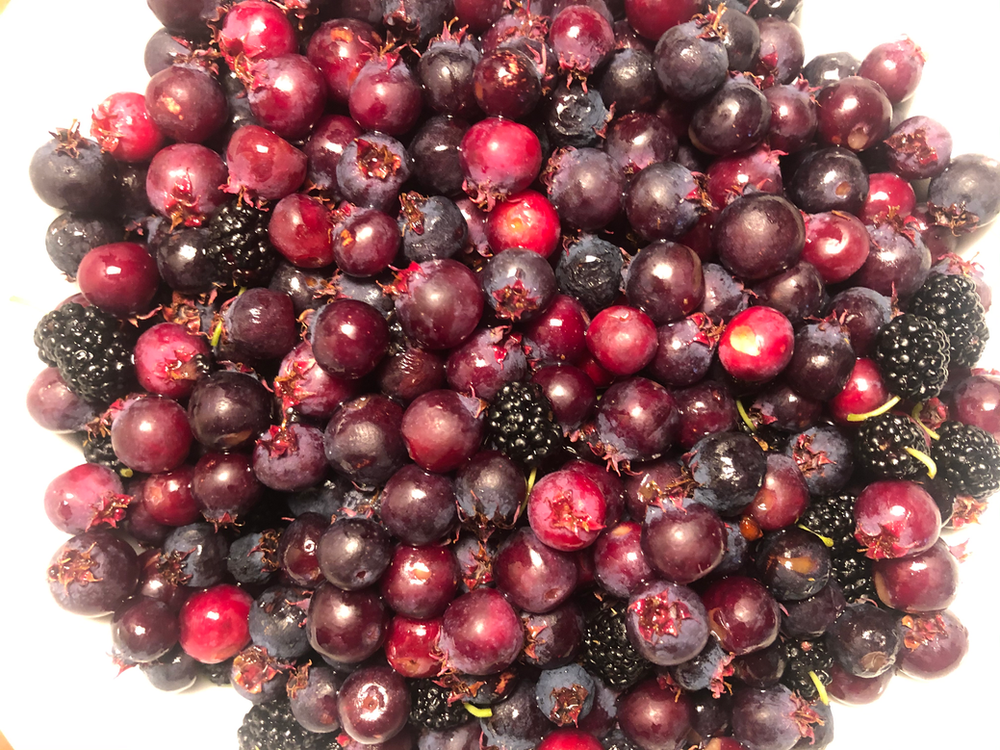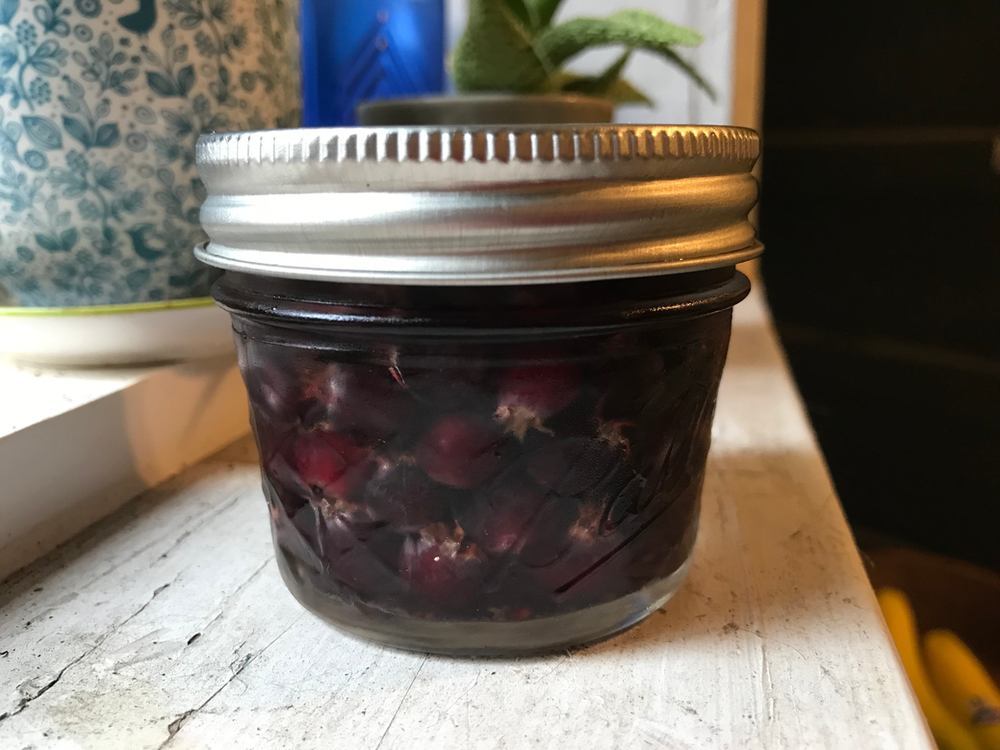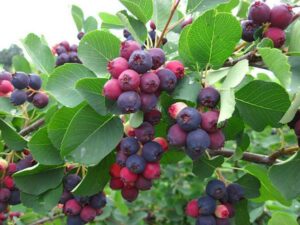
School’s out, it’s officially summer and if that’s not sweet enough, the Serviceberries on the Bloomingdale Trail are now at their peak stage of ripeness. The shrubby tree known botanically as Amelanchier grandiflora x ‘Autumn Beauty’ but also commonly referred to as Serviceberry, Juneberry and Saskatoon, is a beloved multitasker. Serviceberries were intentionally planted trail-wide as a part of a citizen scientist-focused Phenology Project, and volunteers continue to track leaf buds, bloom times, when first fruits appear, leaves change colors and more. And Serviceberries provide a sweet, delicious fruit that makes for an enjoyable snack while up on the Bloomingdale Trail and across Chicago. Human trail users aren’t the only ones who think so, as the berries are a popular food source for local birds, especially robins, who can be heard trilling away from the center of the canopy as they enjoy the fruit.
nn
There are more than 450 Serviceberry trees planted on the Bloomingdale Trail, from Ridgeway to Ashland, so it’s almost impossible to miss them. In Spring, they bloom with lovely white flowers which provide an important pollen source for our earliest pollinators. In Late May the first fruits appear, pale green and full of promise of future sweetness. Come mid-June, the berries turn bright red, then a pale violet and then a deep dark purple, signaling that the fruits are ready to eat. Given this fact, the nickname Juneberries certainly makes sense! In the fall, the leaves of the Amelanchier turn a stunning red/orange/gold, living up to the cultivar name of ‘Autumn Brilliance.’ It’s a tree that plays an important role both as a food source to animals of all sizes and is part of a living lab for our Phenology volunteers and provides natural beauty along the entire length of the trail.
nn
In celebration of the Serviceberries of The Bloomingdale Trail and their abundance of tasty fruit, we are including the following three recipes. Serviceberries are often compared to the taste of a blueberry: a bit less sweet, some say with a tinge of rose. It should be noted that the berries do contain small seeds, which are edible and add a slight nutty flavor. Also, should you want to sample or harvest berries from the trees on the trail, we ask that you respect the universal rule for foraging: only take a small portion from a tree, so that you leave fruit for others, including our feathered friends who rely upon it as a food source. Enjoy!
n

Cyrus’ June-Berry Jam
n
Here’s our jam “recipe” which is a Helphand family favorite. Basically, we go out with Cyrus and pick what’s ripe in our yard mid- to late June. The base is always Serviceberries and Mulberries as they’re usually ripe at the same time. We usually add a stalk or two of rhubarb, and if we have raspberries, currants, or strawberries volunteering, we’ll throw them in too! This early summer jam is good spread on fresh bread, spooned over oatmeal or yogurt, served with cheese or eaten directly from the spoon.
nn
This recipe is dedicated to the foragers of Chicago.
nn
Ingredients
n
2 cups berries — mostly Juneberries & Mulberries, stems removed
n
A stalk (or two) of rhubarb, roughly chopped (optional)
n
¼ cup sugar or honey
n
1-2 tablespoons lemon or lime juice
n
3 tablespoon water, plus more if needed
nn
Directions
n
Put berries through a food mill if you have one. The jam will be seedy if you skip this step, but the seeds are edible, so it’s just a matter of what texture you prefer. In a saucepan on medium-low, simmer the chopped rhubarb (if using) with the water. Add the berries and more water if necessary, one tablespoon at a time. Bring to a low boil for about 10 min or until fruit is cooked down and well combined. If the berries were not milled, mash with a potato masher or the back of a spoon while bubbling, but leave some chunks of fruit – that’s how we like it. Mix in the sugar and reduce to a low simmer until the berry mixture thickens, stirring regularly, about five more minutes. Add lemon juice to taste. Spoon jam into a clean half pint mason jar and enjoy for a week in the fridge. You might have additional jam, anywhere from 4 ounces to a half pint, depending on how much fruit you used. Spoon into an additional jar and use immediately or put in the freezer for future use.
n
—————————-
nn

Soda Bread Scones with Serviceberries
n
These baked morning treats are a hybrid of a scone and a somewhat traditional Irish Soda Bread, with the serviceberries thrown in to give it a local flavor and a bit of sweetness. They have an intentionally healthy vibe and dense crumb (hello, wheat bran) which balances nicely with a big smear of butter, a drizzle of honey or a swipe of your favorite jam. (Cyrus’ Juneberry Jam is excellent on these! Trust us, we did several taste tests.) These scones are best eaten the day they are made, but they also freeze really well for future enjoyment.
nn
Ingredients
n
¾ cup wheat germ
n
¼ cup old fashioned oats
n
1 cup whole wheat flour
n
½ cup all-purpose flour
n
½ teaspoon fine salt
n
½ teaspoon baking soda
n
1 cup buttermilk or plain kefir (plus an extra tablespoon or more if needed)
n
½ cup fresh, frozen or dried serviceberries
n
1 tablespoon unsalted butter, cold
nn
Directions
n
Heat oven to 375 degrees. Line a baking sheet with parchment paper.
n
Place the dry ingredients in a large bowl, whisk to combine. In a smaller bowl, combine the buttermilk or kefir with the serviceberries. Gently mix them together and then pour over the dry ingredients. Coarsely grate the butter over the dry and wet ingredients and then stir to combine everything-it might be a bit stickier than a typical scone dough. If it isn’t coming together, add more buttermilk or kefir, one tablespoon at a time. Using a ⅓ cup measuring cup, scoop up the dough and drop it in mounds on the baking sheet. If you like a little extra sweetness, you can sprinkle a bit of sugar on top of each scone.
nn
Bake for 20 minutes, until just lightly golden brown.
nn
Yield: 8-10 scones
n
————————–

Pickled Serviceberries aka “Midwestern Capers”
n
These pickled serviceberries are excellent on salads, toast or bagels, even on ice cream or in a cocktail or shrub. Feel free to experiment with adding fresh herbs to the jar, such as a sprig of thyme or rosemary or adding black peppercorns or a few slim strips of orange or lemon zest.
nn
This recipe makes “refrigerator pickle” style capers, meaning they are preserved by the brine, not fermentation and should be placed in the refrigerator immediately after making them. They should last two months, if not longer. If you want to process them in a hot water bath so they can be stored unrefrigerated until opened, we suggest following the preserving methods outlined in the Ball Blue Book Guide to Preserving. For this recipe, unripe serviceberries hold up better than ripe but if the berries are already ripening, try to pick those that are more bright red than deep purple.
nn
Ingredients
n
1 cup serviceberries, stems picked off, rinsed and drained
n
4 whole cloves
n
1 tablespoon white wine vinegar
n
½ cup rice vinegar
n
1 ½ cups hot water
n
2 tablespoons sugar
n
1 tablespoon plus 1 teaspoon kosher salt
nn
Directions
n
Spoon the berries into four clean 4-ounce canning jars. Leave at least ½ inch of space at the top of the jar so there is room for the pickling liquid to cover the berries. Drop a clove into each jar.
nn
Combine the vinegars, hot water, sugar and salt in a bowl or pitcher until the sugar and salt have dissolved. Pour or ladle the brine over the berries in each jar. Screw on the lids and place in the refrigerator. The capers should be ready to eat after a few days in the refrigerator.
n




